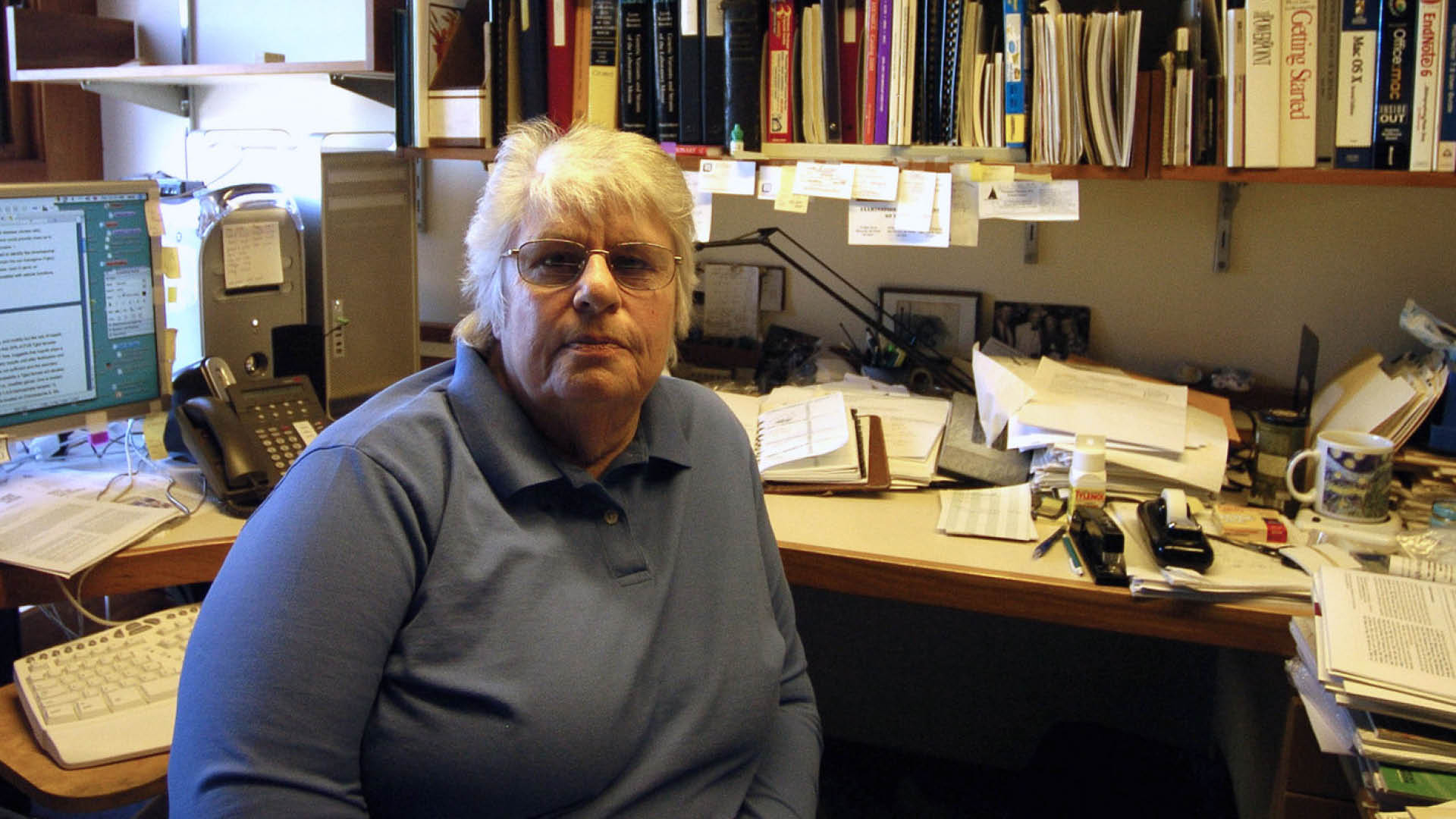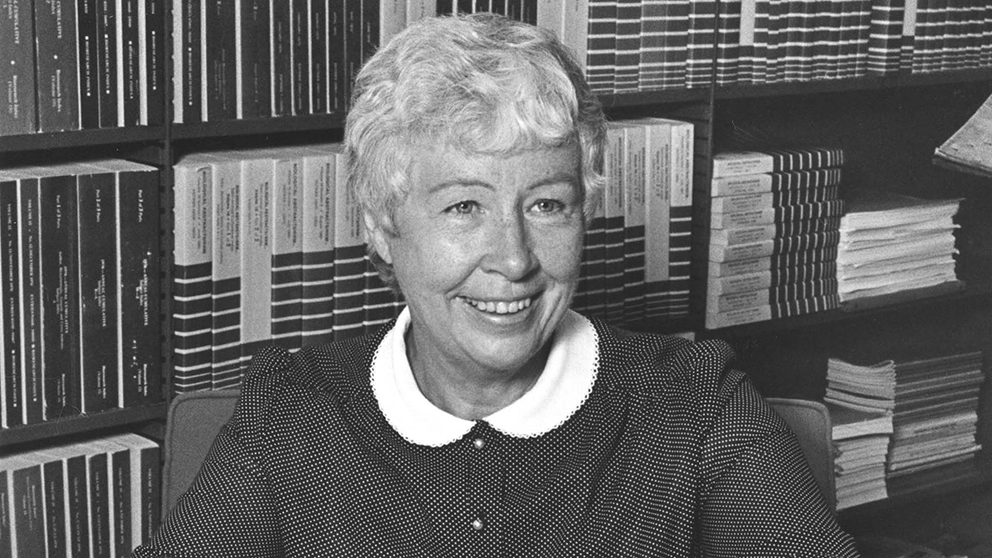
For decades, world-class women scientists have conducted impactful research at The Jackson Laboratory. Here’s a look back at those who paved the way for JAX research that has dramatically improved human health.

Elizabeth ‘Tibby’ Russell, Ph.D.
Known for: Groundbreaking work in pigmentation, blood-forming cells and germ cells
Russell was a pioneer in the field of mammalian developmental genetics. Fascinated by science at an early age, she obtained her Ph.D. in zoology in 1937, and married that same year. When her husband joined the Laboratory staff, Russell was given space in his lab as an independent, unpaid investigator. She published two papers on tumorigenesis – and had four children – before formally joining the staff in 1947. That was the year of the infamous Mount Desert Island fire that destroyed most of JAX’s mouse population, and Russell was tasked with rebuilding it by retrieving JAX mice from scientists around the world. Her enthusiasm and genuine affection for students made her the consummate mentor. Her accolades include an American Academy of Arts and Sciences fellowship, membership in the National Academy of Sciences and a Guggenheim fellowship. Russell became senior staff scientist emeritus in 1978 and continued to work several days a week at the laboratory and, although her activity declined with time, still attended weekly JAX genetics seminars almost until her passing in 2001.

Priscilla ‘Skippy’ Lane
Known for: Co-discovering the first mouse model for obesity
Lane learned about JAX as a University of California Berkeley graduate student in physiology. In a course on growth and form, her professor frequently referenced “Bar Harbor mice” and the work of JAX scientists investigating tumor growth. After receiving her master’s degree, she joined JAX as a research associate in 1951, bringing a physiologist’s perspective to a range of groundbreaking research projects. Working alongside prominent JAX investigator Margaret Dickie, Ph.D., Lane co-discovered the first mouse model for obesity in JAX’s mice colonies. The mouse later proved to have a key mutation in its leptin gene, which played an important role in future award-winning research on obesity and diabetes. In her 56 years as a researcher, Lane authored or co-authored at least 40 scientific publications. She retired in 2007.

Eva Eicher, Ph.D.
Known for: Producing the first animal model for some human sex chromosome abnormalities
Eicher played a pivotal role in understanding mammalian sex determination. After graduate work with renowned JAX geneticist Margaret Green, Ph.D., Eicher joined JAX’s research staff in 1971. In 1978, she and her collaborators published a report on the BALB/c mouse strain as the first animal model for some human sex chromosome abnormalities. She had a huge influence on many JAX scientists, including Associate Professor Steven Munger, Ph.D., who noted that he based much of his postdoctoral research on Eicher’s findings on genes associated with sex determination and reversal. “I love her spirit,” Munger said, “and she has been a wonderful mentor for me.” During her service to JAX until her retirement in 2020, Eicher also instituted standards for the research mouse colonies and served as assistant director of training.

Muriel Trask Davisson, Ph.D.
Known for: Developing a mouse model for Down syndrome
While majoring in German at Mount Holyoke College, Davisson took genetics as part of a basic biology course and knew immediately she had found her passion. She participated in the 1962 JAX Summer Student Program and was asked to a return as a research associate. It was the start of a long career at JAX, where she focused on finding spontaneous gene mutations, genetically mapping and characterizing them, and exploring how abnormalities in chromosomes affect development. She is best known for developing a mouse model for Down syndrome, a condition related to a chromosomal anomaly and linked to mental and physical disabilities in more than 350,000 Americans. Over three decades, her mouse model has proven to be an essential research tool. “It is the model being used by most scientists who are doing research on Down syndrome and studying behavior, memory and how kids learn if they have Down syndrome,” she said. She retired as professor emeritus in 2012.

Barbara Sanford Hugus, Ph.D.
Known for: Serving as JAX’s first and only female director
Hugus first learned about JAX from her Brown University graduate advisor, mammalian geneticist Herman Chase. She went on to become an accomplished geneticist and progressed to faculty positions at Massachusetts General Hospital (Boston), branch chief at the National Institutes of Health, and director of research at the Dana Farber Cancer Institute. While at Dana Farber in 1981, the chair of the JAX search committee called to see if she would consider the position of laboratory director (the position that is now president and CEO). A few months later, Hugus became the first and only female director for JAX (1981-1987). She later served as an honorary trustee of the Laboratory until her passing in 2021. “I think that one of the Laboratory's greatest strengths is its people,” she said in a 1986 interview. “There have always been excellent scientists here…many of whom have stayed for their whole careers. That's unusual, and I think that's a strength.”
Sources/additional reading:
- Russell, Elizabeth, "Elizabeth "Tibby" Russell Oral History" (1986). Oral History Collection. 4. http://mouseion.jax.org/oral_history/4
- National Academies of Sciences, Engineering, and Medicine. 2002. Biographical Memoirs: Volume 81. Washington, DC: The National Academies Press. https://doi.org/10.17226/10470.
- Lane, Skippy, "Priscilla "Skippy" Lane Oral History" (1986). Oral History Collection. 11. http://mouseion.jax.org/oral_history/11
- Sanford, Barbara, "Barbara Sanford Oral History" (1986). Oral History Collection. 10. http://mouseion.jax.org/oral_history/10